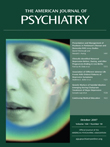Clinically Identified Maternal Depression Before, During, and After Pregnancies Ending in Live Births
Abstract
Objective: This study estimated the prevalence of diagnosed depression and treatment among women before, during, and after pregnancies ending in live births. Method: A previously validated algorithm identified health plan members with at least one pregnancy between Jan. 1, 1998, and Dec. 31, 2001. Women with a pregnancy ending in one or more live births and continuously enrolled from 39 weeks before pregnancy through 39 weeks after pregnancy were eligible. Maternal depression was identified from the medical records. Depression treatment included antidepressant medication and/or mental health visits. The authors examined the prevalence of depression and treatments received. Results: Among 4,398 continuously enrolled women with eligible pregnancies ending in live births, 678 (15.4%) had depression identified during at least one pregnancy phase; 8.7%, 6.9%, and 10.4% had depression identified before, during, and/or after pregnancy, respectively. Among women with identified depression during the 39 weeks before pregnancy, 56.4% also had a depression diagnosis during pregnancy. Of women identified with depression during the 39 weeks following pregnancy, 54.2% had depression diagnoses either during or preceding pregnancy. Most women diagnosed with depression received antidepressant medications and/or had at least one mental health visit. Having at least one mental health visit did not vary before, during, or after pregnancy; however, antidepressant use was lower during pregnancy than before or after pregnancy. Conclusions: Approximately one in seven women was identified with and treated for depression during 39 weeks before through 39 weeks after pregnancy, and more than half of these women had recurring indicators for depression.



